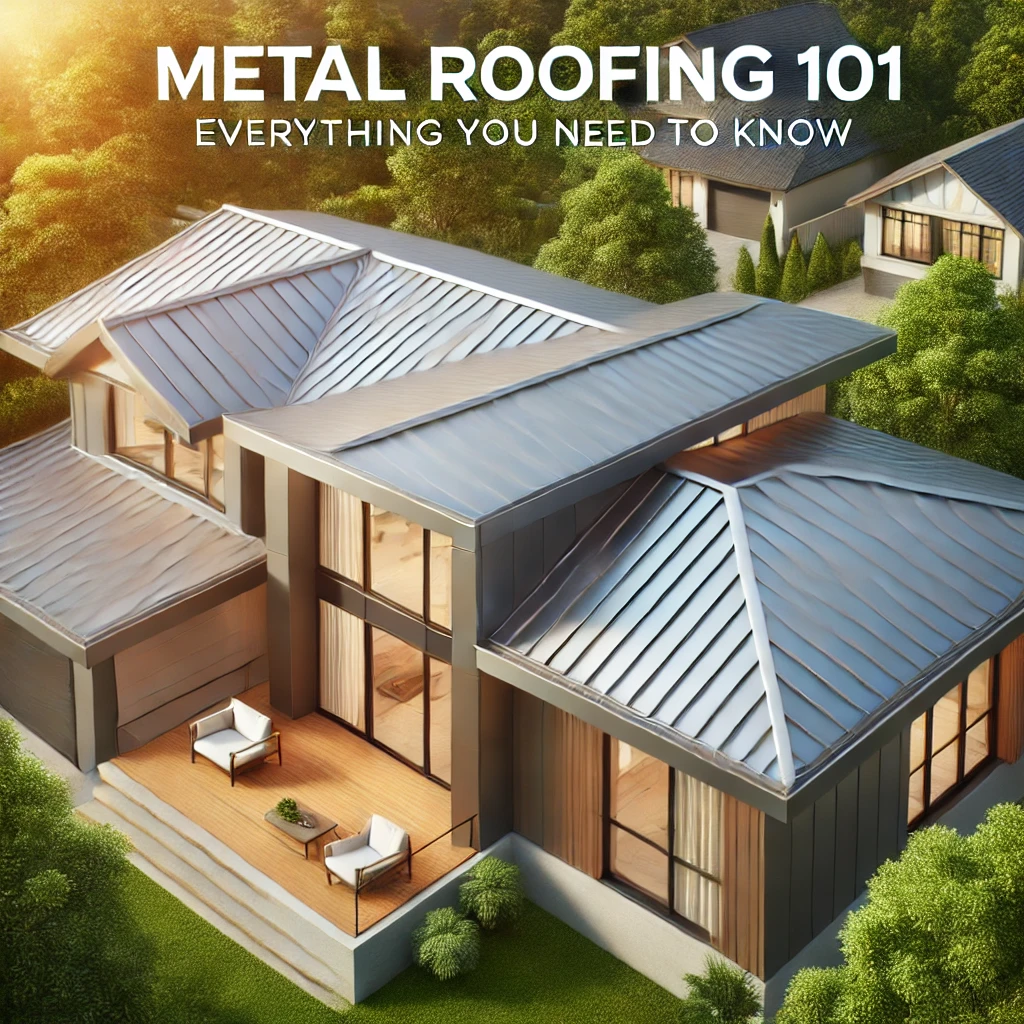Metal Roofing 101: Everything You Need to Know Before You Start
Metal roofing has become an increasingly popular choice for homeowners and builders due to its durability, energy efficiency, and sleek appearance. But what exactly is metal roofing, and is it the right choice for your home? In this guide, we’ll cover everything you need to know about metal roofing, from the basics to its advantages and potential drawbacks. By the end, you’ll have a clear understanding of whether metal roofing is the best fit for your needs.
What Is Metal Roofing?
Metal roofing is a type of roofing material made from various metals, including steel, aluminum, copper, and zinc. These materials are formed into panels or shingles, which are then installed on the roof. Metal roofs come in different styles and finishes, allowing homeowners to achieve a range of looks—from modern to traditional.
Common Types of Metal Roofing:
- Standing Seam Metal Roofing: Features vertical panels with seams that interlock, providing a sleek and modern appearance.
- Corrugated Metal Roofing: Includes wavy or ridged panels, commonly used for industrial or rustic designs.
- Metal Shingles: Mimic the look of traditional shingles, wood shakes, or slate while offering the benefits of metal.
- Stone-Coated Steel Roofing: Combines the durability of metal with a textured finish for a more traditional aesthetic.
Advantages of Metal Roofing
1. Longevity
One of the biggest benefits of metal roofing is its lifespan. While asphalt shingles typically last 20-30 years, metal roofs can endure for 40-70 years or more, depending on the material.
2. Durability
Metal roofs are resistant to extreme weather conditions, including heavy rain, high winds, snow, and hail. They’re also fire-resistant, making them a safer option in wildfire-prone areas.
3. Energy Efficiency
Metal roofs reflect solar heat, which can reduce cooling costs by up to 25%. Installing a metal roof with a cool coating can further enhance its energy-saving benefits.
Related Read: Learn more about energy-efficient roofing materials in our guide to energy-efficient metal roofing.
4. Sustainability
Many metal roofing materials are made from recycled content and are 100% recyclable at the end of their life. This makes them an eco-friendly choice compared to other roofing options.
5. Low Maintenance
Unlike other roofing materials, metal roofs require minimal maintenance. Periodic inspections and cleaning are usually enough to keep them in good condition.
Disadvantages of Metal Roofing
While metal roofing offers many benefits, it’s important to consider potential downsides:
1. Higher Initial Cost
Metal roofing is more expensive upfront than asphalt shingles. However, its longevity and energy savings often make it a cost-effective investment over time.
2. Noise
Some homeowners find that metal roofs can be noisy during heavy rain or hail. Adding insulation or installing a solid sheathing can help minimize this issue.
3. Expansion and Contraction
Metal expands and contracts with temperature changes, which can cause fasteners to loosen over time. Choosing a qualified installer can mitigate this issue.
4. Denting
While highly durable, metal roofs can dent if struck by heavy objects, such as falling branches or large hailstones.
How to Choose the Right Metal Roof for Your Home
When deciding on a metal roof, consider the following factors:
1. Material
- Steel: Strong and cost-effective, often coated with a protective layer to prevent rust.
- Aluminum: Lightweight and rust-resistant, ideal for coastal areas.
- Copper: Highly durable and develops a unique patina over time, but expensive.
- Zinc: Known for its self-healing properties, great for custom designs.
2. Style
Choose a style that complements your home’s architecture. For example, standing seam panels offer a modern look, while metal shingles mimic traditional materials.
3. Coatings and Finishes
Opt for a finish that improves energy efficiency and enhances durability. Reflective coatings can help reduce heat absorption.
4. Budget
Balance upfront costs with long-term benefits. While metal roofing may cost more initially, its durability and energy efficiency can save you money in the long run.
Related Read: Compare the costs of different roofing options in our article on roofing material cost comparison.
Installation Process
Metal roofing installation is a precise process that requires professional expertise. Here are the basic steps:
- Inspection and Preparation
- Assess the roof’s structure and repair any damage.
- Remove old roofing materials if necessary.
- Install Underlayment
- A waterproof underlayment is installed to protect the roof deck from moisture.
- Install Panels or Shingles
- Metal panels or shingles are placed on the roof, starting from the bottom edge and working upward.
- Secure Fasteners and Seams
- Ensure all fasteners are secure and seams are properly sealed to prevent leaks.
- Final Inspection
- Inspect the roof to ensure proper installation and address any issues.
Maintenance Tips for Metal Roofs
Maintaining a metal roof is simple and can extend its lifespan:
- Clean the Surface: Remove debris, dirt, and leaves to prevent water pooling.
- Inspect Regularly: Check for loose fasteners, damaged panels, or signs of rust.
- Repair Damage Quickly: Address any dents, scratches, or rust spots to prevent further issues.
For a deeper dive into maintenance, check out our guide on how to maintain a metal roof.
Final Thoughts
Metal roofing is an excellent choice for homeowners seeking a durable, energy-efficient, and sustainable roofing solution. While the initial cost may be higher, the long-term benefits make it a worthwhile investment. Whether you’re building a new home or replacing an old roof, metal roofing offers versatility, style, and performance that’s hard to beat.
If you’re considering metal roofing, take the time to research materials, styles, and installers to ensure the best results. With proper care, your metal roof can last for decades, providing peace of mind and protection for your home.

